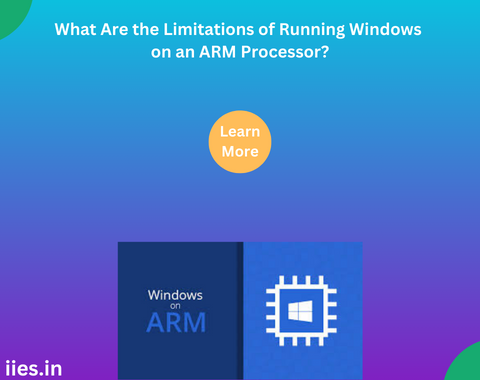
The realm of computer processors has witnessed a constant evolution, and one of the noteworthy developments in recent years is the rising prominence of Arm processors. Traditionally associated with mobile devices and embedded systems, Arm processors are making inroads into the realm of personal computing. A fundamental question that arises is whether Arm processors can effectively run the ubiquitous Windows operating system. In this article, we delve into the intricacies of this compatibility, exploring the challenges, advancements, and the potential implications for the computing landscape.
Arm (Acorn RISC Machine) architecture, developed by Arm Holdings, has undergone a remarkable evolution since its inception. Initially designed for low-power devices, such as smartphones and tablets, Arm processors have demonstrated their efficiency in terms of performance per watt. This efficiency has contributed to their widespread adoption in various electronic devices beyond mobile platforms, including Internet of Things (IoT) devices, automotive systems, and more.
The Arm architecture employs a Reduced Instruction Set Computing (RISC) design philosophy, emphasizing simplicity and efficiency. RISC architecture allows for faster execution of instructions, making it suitable for power-constrained environments. Over time, Arm processors have become increasingly powerful, challenging the dominance of x86 architecture in certain computing domains.
Windows on Arm: A New Horizon:
Historically, Microsoft’s Windows operating system has been closely associated with x86 architecture, the architecture used by processors from Intel and AMD. However, recognizing the changing landscape and the potential benefits of Arm architecture, Microsoft initiated the development of Windows on Arm. This move aimed to extend the Windows ecosystem to a broader range of devices, particularly those powered by Arm processors.
Windows on Arm is a version of the Windows operating system that has been optimized to run on Arm-based processors. The goal is to provide a seamless user experience while leveraging the power efficiency and performance characteristics inherent to Arm architecture. Microsoft’s collaboration with Qualcomm in the development of the Snapdragon processor series further exemplifies the commitment to bringing Windows to Arm devices.
Challenges in Porting Windows to Arm:
Despite the promise of Windows on Arm, the transition has not been without challenges. One of the primary hurdles lies in the legacy software and applications designed specifically for x86 architecture. Compatibility issues arise when attempting to run x86-based applications on Arm processors, necessitating emulation or virtualization solutions.
Emulation involves translating x86 instructions into Arm instructions on-the-fly, allowing legacy applications to run on Arm-based systems. While emulation can provide compatibility, it often comes with a performance overhead. Virtualization, on the other hand, involves running an entire x86 operating system within a virtual machine on an Arm-based system. Both approaches aim to bridge the gap between the two architectures, but they introduce complexities that may impact performance and user experience.
Windows 10 on Arm:
Microsoft’s efforts in the realm of Arm compatibility culminated in the release of Windows 10 on Arm, a version of Windows specifically tailored for Arm processors. This version brings native support for Arm architecture, eliminating the need for emulation in many cases. Windows 10 on Arm supports both traditional desktop applications and Universal Windows Platform (UWP) apps, ensuring a diverse range of software compatibility.
In addition to software compatibility, Microsoft has worked on optimizing Windows 10 on Arm for power efficiency, a crucial aspect given Arm’s prevalence in mobile and battery-powered devices. This optimization includes features such as Connected Standby, enabling instant-on capabilities and improved battery life.
Arm in Personal Computing:
The compatibility of Arm processors with Windows has implications beyond the realm of traditional desktop and laptop computers. The rise of Arm-based personal computers (PCs), often referred to as Always Connected PCs, represents a shift in the landscape. These devices leverage Arm architecture to deliver a balance of performance and energy efficiency, catering to users who prioritize mobility and long battery life.
Always Connected PCs, powered by Arm processors, often feature integrated cellular connectivity, providing users with constant internet access without relying solely on Wi-Fi. This connectivity, combined with the inherent power efficiency of Arm architecture, aligns with the evolving needs of a connected and mobile-centric world.
The Future of Arm and Windows Collaboration:
The collaboration between Arm and Microsoft continues to evolve, with both companies investing in research and development to enhance the Windows on Arm experience. The announcement of Windows 11 and its compatibility with Arm processors further solidifies the commitment to this collaboration.
Windows 11 on Arm builds upon the foundation laid by Windows 10 on Arm, with improvements in performance, compatibility, and user experience. The new operating system aims to deliver a cohesive and consistent interface across different device form factors, including tablets, 2-in-1s, and traditional laptops.
As the ecosystem around Arm processors expands, developers are increasingly optimizing their applications for Arm architecture, reducing reliance on emulation or virtualization. This shift contributes to a smoother and more efficient user experience on Arm-based devices running Windows.
The compatibility of Arm processors with the Windows operating system marks a significant stride in the evolution of computing architectures. Microsoft’s commitment to optimizing Windows for Arm and collaborating with Arm Holdings and other hardware manufacturers underscores the industry’s recognition of the potential of Arm in personal computing.
While challenges persist, advancements in software optimization and the development of purpose-built hardware contribute to a more seamless integration of Windows on Arm. The rise of Always Connected PCs and the support for Arm architecture in Windows 11 signal a future where Arm processors play a more prominent role in shaping the landscape of personal computing. As the collaboration between software and hardware ecosystems matures, the synergy between Arm processors and Windows is likely to redefine the boundaries of performance, efficiency, and connectivity in the computing world.
Indian Institute of Embedded Systems – IIES